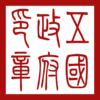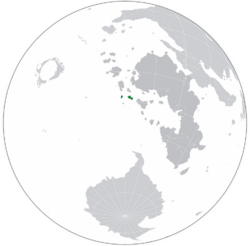Mitō
Five Provinces 五國 Gokoku (Mitonese) | |
|---|---|
| Anthem: "Gokago o" (ご加護を, "Blessings") | |
| Government seal 五國政府印章 "Government Seal of the Five Provinces"  Royal Seal 王國璽  | |
 The Five Provinces (dark green) in Aurelia (dark grey) | |
| Capital | Kenkyō |
| Government seat | Kauhime |
| Other languages | Mitonese |
| Demonym(s) | Mitonese |
| Government | Absolute monarchy under a parliamentary democracy |
• Emperor | Tomoharu |
• Governor | Rion Kenichi |
| Legislature | Legislative Diet |
| Formation | |
| 98 BCE | |
| 11 September 1957 | |
| Area | |
• Total | 59,355 km2 (22,917 sq mi) |
| Population | |
• 2021 estimate | 9,723,000 |
• 2011 census | 9,619,251 |
| GDP (PPP) | 2020 estimate |
• Total | |
• Per capita | |
| GDP (nominal) | 2020 estimate |
• Total | |
• Per capita | |
| Gini (2020) | medium |
| HDI (2020) | very high |
| Currency | Ryau (MR) (MRY) |
| Date format | YYYY-MM-DD |
| Driving side | left |
| Calling code | +745 |
| Internet TLD | |
Mitō (Mitonese: 魅島, Mitō or Mitau) known officially as the Five Provinces (Mitonese: 五國 , Gokoku) is an island country in Aurelia. It shares a maritime border with Great Xio to the east. The country covers an area of 59,355 square kilometres and has a population of approximately 9,723,000 people. Its capital is Kenkyō and its government seat is in Kauhime which alongside surrounding cities forms the country's metropolitan area. The climate of the country varies significantly from temperate to humid from island to island.
Etymology
Geography
North coast of Gamejima
Bamboo in Kauhime Central Park
Rock formation off the coast of Shinjutō
The Kenjin Boulder in Kannan
History
Politics
Government
The Five Provinces is a unitary absolute monarchy under a parliamentary democracy. The head of state is the emperor (Mitonese: 天子, tenshi), and the head of government is the governor. The emperor is traditionally considered to be the divine ruler or Great King (大君/大王, о̄kimi) of the Mitonese people and is recognised as the wielder of the highest political authrotiy in the country. However, in practice the head of state does not exercise political power apart from judicial oversight in the form of appointments to the Royal Judiciary Commission. In addition, the emperor is seen was wielding significant legislative and executive oversight since any expression of imperial discontent with an official on the part of the emperor has always led to the resignation of said official.
The governor (知事, chiji) is the head of the executive branch of the government of the Five Provinces. The head of government is not directly appointed by the head of state instead the governor is selected by the Diet and is most often the leader of the largest political party. The governor rules based on their ability to command confidence within the Diet. Unlike in many other parliamentary democracies, head of government operates with the implicit approval of the emperor and is not appointed by the latter. As such duties often reserved for the head of state are conducted by the governor such as the approval of legislation and foreign policy.
The Diet of the Five Provinces known simply as the Diet (議會, gikai) is the country's unicameral legislature. It has the power to alter laws and dismiss the cabinet and governor. The GDT has dominated the Diet since the 1930s often winning 60-80% of the popular vote. 100 of its 314 seats are appointed by the Electoral Commission whose members are in turn appointed by the governor. 169 seats are a part of the Interelectorate Compact meaning they are elected on the basis of proportional representation. The remaining 45 seats are elected using the first-past-the-post election system. A cabinet led by the governor is formed following parliamentary elections to the Diet.








